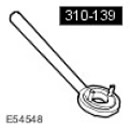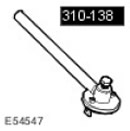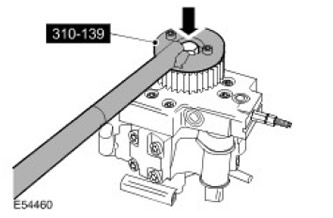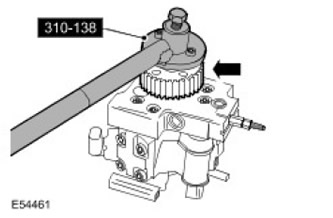Special tool
 Holding device 310-139 Holding device 310-139 |  Puller 310-138 Puller 310-138 |
Removing
WARNING: Do not carry or use a cell phone while working on or near any fuel related items. In such situations, there are always highly flammable mixtures that can ignite. Failure to follow these instructions may result in injury.
CAUTION: Do not perform any fuel system repairs while the engine is running. The fuel pressure in the system can reach 1650 bar. Failure to follow this instruction may result in injury.
WARNING: Do not smoke or walk with a lit cigarette or open flame of any type while working on or near fuel related items. In such situations, there are always highly flammable mixtures that can ignite. Failure to follow these instructions may result in injury.
CAUTION: This procedure is related to fuel handling. Always be aware of the possibility of fuel splashing and observe fuel safety precautions. Failure to follow these instructions may result in injury.
CAUTION: Make sure that the workshop area where the vehicle is being worked on is as clean and dust free as possible. Dirt and dust from working on the clutch, brakes, or from machining or welding operations can contaminate the fuel system and cause performance problems.
CAUTION: Always perform the cleaning procedure before making any repairs to the fuel injection system components. Failure to follow this instruction may result in dirt entering the fuel injection system.
WARNING: Diesel fuel injection equipment is manufactured to very precise tolerances and with very close clearances. Therefore, when working with these elements, it is especially important to observe absolute cleanliness. Open holes or lines should always be plugged with appropriate plugs. Failure to follow this instruction may result in dirt entering the fuel injection system.
WARNING: Do not disassemble the fuel pump or clean the inside of it, even with ultrasonication. Always install a new fuel pump if necessary.
1. Disconnect a wire of weight from the accumulator. For more information refer to Specification.
2. Remove the crankcase ventilation oil separator.
3. Remove the high pressure fuel pump drive belt cover.
- Move the engine wiring harness to the side to access the injection pump drive belt cover.
- Release two clamps.

4.
NOTE: The high pressure fuel pump drive belt is not connected to the engine timing.
Remove the high pressure fuel pump drive belt tensioner and discard it. Turn out the left fastening bolt.

5.
NOTE: The high pressure fuel pump rotates counterclockwise when viewed from the rear of the engine.
Remove the high pressure fuel pump drive belt and discard it.

6. Turn out bolts of fastening of a back cover of a belt of a drive of the fuel pump of a high pressure.

7. Remove the crankcase ventilation oil separator mounting pin.

8.
NOTE: Left side shown, right side done in the same way.
Release the high pressure fuel supply lines. Turn out a bolt.
9.
CAUTION: Ensure that the high pressure fuel supply line remains in contact with the fuel pump and intermediate fuel manifold until both connections are disconnected and cleaned. Failure to follow this instruction may result in dirt entering the fuel injection system.
NOTE: Left side shown, right side done in the same way.
Remove the high pressure fuel supply lines and discard them. Insert plugs into open holes.

10. Release the fuel supply wiring harness. Loosen the nut.

11. Remove the intermediate fuel manifold. Remove two pins.

12. Remove the high pressure fuel pump. Turn out four bolts.

13.
NOTE: Do not proceed with disassembly if the element is being removed only to gain access.
Using the special tool, loosen the high pressure fuel pump pulley nut.

14. Using the special tool, remove the high pressure fuel pump pulley.

Installation
1. Using the special tool, install the high pressure fuel pump pulley. Tighten to 50 Nm.

2. Install the high pressure fuel pump. Tighten the bolts to 23 Nm.
3. Screw in bolts of fastening of a back cover of a belt of a drive of the fuel pump of a high pressure. Tighten to 7 Nm.
4.
CAUTION: Do not install a new injection pump belt on the pulleys with the tensioner installed. Failure to follow this instruction may result in damage to the fuel pump belt.
NOTE: The high pressure fuel pump rotates counterclockwise when viewed from the rear of the engine.
Install a new high pressure fuel pump belt.
5.
CAUTION: Make sure that the high pressure fuel pump drive belt tensioner tab is correctly positioned in relation to the back cover of this belt. Failure to follow these instructions may result in engine damage.
Install a new high pressure fuel pump belt tensioner.
- Insert the tab on the new injection pump belt tensioner into the injection pump rear cover.
- Tighten to 25 Nm.
- Remove the injection pump drive belt tensioner locking rod and discard it.

6. Install the high pressure fuel pump drive belt cover. Move the engine wiring harness to the side to access the injection pump drive belt cover.
7. Install the intermediate fuel manifold. Install the two mounting studs, but do not fully tighten them at this stage.
8. Fix a plait of electroconducting of system of giving of fuel. Screw on the nut.
9. Install new high pressure fuel feed lines.
- Open the holes closed with plugs.
- Install new high pressure fuel feed lines, but do not permanently fix.
- Tighten the intermediate fuel manifold mounting studs to 23 Nm.
- Step 1: Tighten the high pressure fuel supply pipe nipple on the fuel rail to 15 Nm.
- Stage 2: Tighten the high pressure fuel supply pipe nipple on the intermediate fuel manifold to 15 Nm.
- Stage 3: Tighten the nipple connection of the high pressure fuel supply line on the fuel manifold to 30 Nm.
- Step 4: Tighten the high pressure fuel supply pipe nipple on the intermediate fuel manifold to 30 Nm.
- Screw in two bolts.
- Tighten to 10 Nm.

11. Screw in the crankcase ventilation oil separator mounting pin. Tighten the nut to 10 Nm.
12. Install the crankcase ventilation oil separator.
13. Connect a wire of weight to the accumulator. For more information refer to Specification.
14. Remove air from the fuel supply system. For more information, refer to Bleeding the Low Pressure Fuel System (19.50.07)
Comments on this article